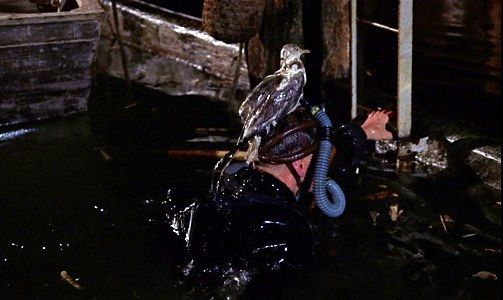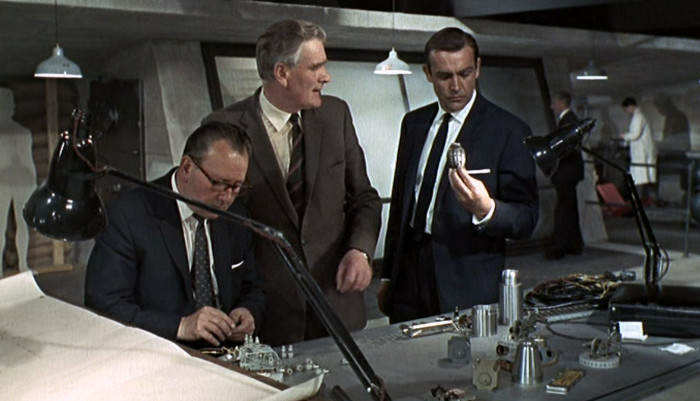When Q (Desmond Llewelyn) tells James Bond (Sean Connery) about his new car being equipped with an ejector seat, Bond is incredulous. “Ejector sh-eat! You’re joking!” Q isn’t, and 1964’s Goldfinger wasn’t messing around either. The first Bond blockbuster, released 50 years ago this week, was when the whole 007 jamboree permanently became a series of pseudo sci-fi flicks.
Though the third James Bond film released, Goldfinger is the one that brought on an obsession with espionage thrillers that cinema has not given up since. For a science fiction fan—or at least someone who enjoys fictional applications of possible technologies—Goldfinger is the grandpapa of a lot of gadget-heavy films, with the recent Christopher Nolan’s Dark Knight trilogy predominantly coming to mind. And while Bond films previous to Goldfinger featured a few pieces of technology, it was never the Sky Mall catalogue of outrageous spy-stuff like this movie became. To put it in perspective: From Russia to Love (1963) had a suitcase with some hidden compartments. Goldfinger (1964) has a car with machine guns, oil slick spewer, bullet-proof shields, a thingy for messing up someone’s tires like you’re Speed Racer, and, as mentioned, an ejector seat. Take that, trick suitcase.

Bond’s tech starts out decidedly low in this film, with his very first “gadget” being a fake seagull on his head. That’s right, the supposed coolest and most famous Bond film of them all begins with double-oh seven paddling around underwater, with his head disguised by wearing a fake bird on top of it. This sequence doesn’t last for long, and soon it transitions into the now infamous tuxedo-underneath-a-wetsuit-situation. But, later, when Bond is actually on the tail of illegal gold-launderer and all-around jerk Goldfinger, it’s time for Bond to get issued all his proper gadgets, including the infamous Aston-Martin DB5.
Though James Bond will drive some other cars throughout the years and some of them will be able to do more than have an ejector seat, be able to drive underwater, etc., none will be as iconic. Every time a James Bond movie wants to remind you that it’s a James Bond movie, he’ll be driving this car. At the beginning of GoldenEye (arguably a kind of reboot for the Bond franchise in 1995) Pierce Brosnan’s Bond drives an Aston-Martin in the film’s opening playful car chase. In both Casino Royale (2006) and Skyfall (2012), Daniel Craig’s Bond drives the same car, and in the latter film, its intoned that this is totally the same car as Craig jokingly threatens to eject Judi Dench, to which she replies “go ahead, eject me, see if I care.” (If you want a wacky theory as to how this might literally be the same car, check this out.)
Another icon that Goldfinger introduces isn’t actually a thing so much as a type of scene. When Q—Bond’s master of gadgets— shows 007 all the cool stuff he gets to cart around, the franchise ended up establishing a type of scene that played out over and over through the series of films, and can be found in other spy and heist movies. Batman Begins has the exact same scene between Bruce and Lucius Fox when they’re constructing the Batsuit and related vehicles and gear.

What about the bad guys? Well, James Bond may have had nifty electronic trackers that you put on people’s cars and the cool car itself, but the bad guys in Goldfinger have sci-fi inventions, too. In a super iconic scene, Goldfinger nearly cuts James Bond in half with an “industrial laser,” while Bond is tied to a bed (or something) of pure gold. This is a change from the novel in which Bond is strapped to a regular wooden table, and Goldfinger has a buzzsaw running up it. See! The book isn’t always better, particularly when lasers are involved. Plus, the whole cliché of super villains having lasers starts right here, and if this secret agent lives in a world of lasers, then saying he isn’t in a science fiction movie seems almost blasphemous.
Goldfinger’s scheme to use radiation to make the gold supply of Fort Knox worthless is also a little bit sci-fi, insofar as it requires a totally fictional (and outrageous) application of real science in order to pull off a high-tech heist. Now, though Goldfinger misunderstands the economy a little bit, and seems to have some other basic cognitive problems, it’s notable that this James Bond movie doesn’t end with a mad genius who is pointing a death ray at the entire world, as many, many other James Bond films do. In fact, when James Bond goes full sci-fi in Moonraker, the obliteration of everyone on Earth is exactly what’s at stake and lasers are everywhere.

But Goldfinger is a way more serious sci-fi movie than Moonraker, insofar as any James Bond movie can be called a “serious” anything. It tries a little harder than some of the films that follow it. In 1964 lasers were still novel, and the scheme of using radiation on gold seems more clever and complicated than several subsequent Bond-baddie plans. Plus, because the Aston-Martin is a real car, and everything about the car chase is realistic, it’s exciting. The Bond films would temporarily forget how to do this, and un-ironically or not gave James Bond an invisible car in 2002’s Die Another Day. I’ll say it again: the cool car that he drives is something we can’t actually see.
For now though, if you want to have a vodka martini, shaken, stirred, or even without any vodka, watching Goldfinger on its 50th birthday is a quick and easy way to see where science fiction started sneaking into spy films. And where spy films started sneaking into science fiction films.
Ryan Britt is a longtime contributor to Tor.com.










